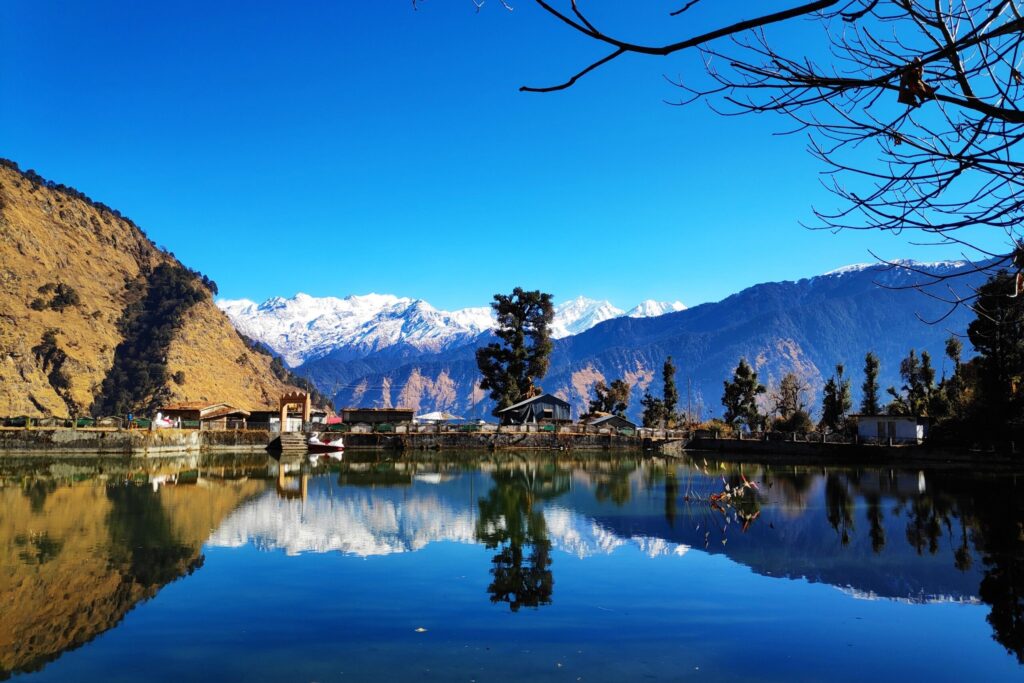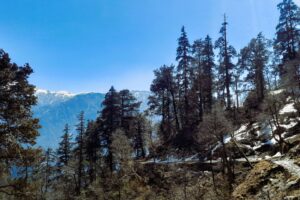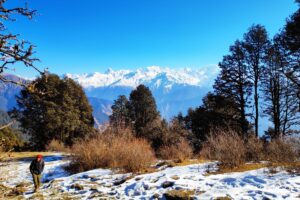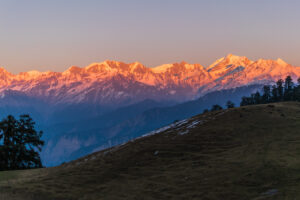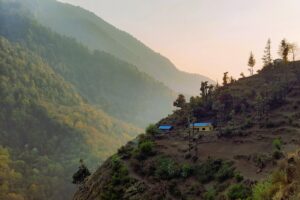- Overview
- Trip Outline
- Trip Inclusion
- Trip Exclusion
- Gallery
- Booking
- FAQs
The Trek
Chadar is a trek that needs little introduction. It has gained fame internationally as one of the treks you have to put as on your bucket list– after all, the trek is entirely on a frozen river. The Zanskar river, which incidentally is a rafting destination in summer, comes to a standstill in the winters and becomes a route that connects Zanskaris to rest of Ladakh. No day on the frozen Zanskar, called the Chadar meaning “blanket”, is the same. Sometimes the ice you walk on is a thick sheet of white, sometimes it is a transparent and you see the frozen bubbles rising to the surface. And sometimes the ice curves around the gorge and the electric blue river gasps to life in middle. This trek is an experience. Couple it with the seclusion of Ladakh in winters and you have yourself a unique winter experience!
The Area
Ladakh is bordered by the Greater Himalayas in the west and south, the Karakoram in the north and the Tibetan Plateau in the east. These ranges form a natural barrier and does not allow clouds to enter this valley making it a rain shadow region and thus a cold desert. The term Ladakh translates to land of high passes. Some of the highest motorable roads in the world are here.In winters Leh isn’t accessible by road and most tourist places are shut barring a few hotels and a few sightseeing places.
Expected Weather
- Snow/Snowfall on trail – Very likely
- Minimum Temperatures – The temperature is a lot cooler in Leh as compared to other areas in the Himalayas.
Afternoon upto -5 degrees
Nights – Around -30 degrees (extreme)
DISCLAIMER FOR CHADAR TREK:
Over the recent years the Chadar trek has become very unpredictable. Due to the changing weather patterns the Chadar does not form as it used to earlier. Additionally, the Government and police authorities too have gotten involved in the running of the Chadar trek which results in added complications. They come up with last minute regulations, at times they cancel the entire Chadar expedition, not allowing any trekkers to go on the Chadar due to the unpredictability of its forming.
Keeping into account all of the above, in the likelihood of the Chadar trek being cancelled (by the government/police authorities or it not being formed), we will take the participants on an alternate trip in Ladakh. This trip will include trekking in and around Ladakh, maybe snow leopard spotting hike. The itinerary for this trip will be shared in case when Chadar trek gets cancelled.
Kindly note, we will not be issuing a refund or a voucher if the Chadar trek gets cancelled. We will be taking all the participants on an alternate trek/trip in Ladakh itself.
- Day 1: Arrive at Leh (3300 mts)
Evening hike to Shanti Stupa for Acclimatization.
Overnight stay in a Hotel - Day 2: Acclimatization day at Leh
You can devote today for local sightseeing. A vehicle can be arranged for you at an additional cost.
Trek briefing in the evening.
Overnight stay in a Hotel - Day 3: Mandatory medical check up at SNM Hospital
According to the new rule laid out by ALTO(All Ladakh tour operators association),trekkers attempting Chadar are supposed to undergo a mandatory medical check up at SNM hospital on the 3rd day after arrival. Trekkers failing to do this will be not allowed to go on the trek.
Overnight stay in a Hotel - Day 4: Drive to Shingra Yokma from Leh via Chilling and trek to Tsomo Paldar
Drive 65 kms
Trek Distance - 3Kms, Trek Time - 2 Hours
Overnight at campsite on Chadar - Day 5: Trek from Tsomo Paldar to Tibb Cave
Trek Distance -10 Kms, Trek Time -6-7 hours
Overnight at campsite on Chadar - Day 6: Trek from Tibb cave to Nerak via Hotong
Trek Distance -18 kms , Trek Time - 6-7 hours
Overnight at campsite at Hotong on Chadar - Day 7: Trek from Hotong to Yokmado
Trek Distance - 13 kms, Trek Time - 6-7 hours
Overnight at campsite on Chadar - Day 8: Trek from Yokmado to Shingra Yokma
Trek Distance - 10 kms, Trek Time -5 hours,
Drive 3 hours
Overnight stay in a Hotel - Day 9: Trek ends today
Drop arranged for airport
- Complete Food (except lunches in Leh)
- Complete accommodation (Twin/Triple sharing basis) for the entire trek
- Hotel stay in Leh
- Airport Pickup and Drop. (On trek specific dates only. Note you have to manage your travel yourself if you come early or leave later)
- Rentals for all common gear provided to you like tent, sleeping bags, crampons etc.
- Technical gear provided to you like Ropes, harness, carabiners and crampons
- Camping charges
- Guide and expertise charges
- 5% GST
- Meals or drinks purchased by participants during the travel or trek (example biscuits, fruits etc)
- Rentals for personal gear (Refer things to get section)
- Trek Insurance – Insurance is available at ₹2000 at Leh for the duration of stay.
- Medical checkup cost on day 3 – ₹500/- approximately (payment to be made at the checkup post directly)
- ALTOA (ALL LADAKH TOUR OPERATORS ASSOSIATION ) Fees to facilitate medical check up – ₹1200/- approximately (payment to be made at the checkup post directly)
- Forest entry permission – The forest department charges ₹2500/- approximately per trekker as forest entry fees only after you clear the medical checkup on day 3 (payment to be made at the checkup post directly)
- Any extra government charges.
- Flight/Train/Bus ticket till Leh.
- Backpack offloading charges. You are expected to carry your own backpack. Trekkers unable to do so can opt for a porterage service at 600/day
- Staff Tips
Leh is only accessible by flight in winters. It is advised you book your flight tickets as early as possible.
Yes, one can go to these places providing you are acclimatizing well. We can arrange a cab at an additional cost for all the participants that are interested.
A certified trek leader, a guide, cook & porters will accompany you during the trek
This is not a very difficult trek as you hardly gain altitude. On most occasions it is just a plain walk, so one doesn’t require a great deal of physical preparation. The cold is a bigger challenge. First timers can do this trek, provided they have good personal gear that keeps them warm.
We’ve been organizing treks for over five years and have had many female trekkers trek with us. In fact, a lot of them come solo for treks. There has never been a complaint about the atmosphere of a trek, about other trekkers or our professionalism. They have all been kind enough to leave a review.
In all the camps where the accommodation is in tea houses/ home stays, there will be proper toilets. The toilets are mostly western, incase if they‘re Indian, then we try to provide a toilet seat most of the times.
On the day of camping, we will have toilet tents (with a dry pit toilet), the most hygienic way of answering nature’s call.
A dry pit toilet is an eco-friendly sanitation solution featuring a pit dug into the ground, topped with a toilet seat and a wrought iron stand. Near the toilet, a pile of mud, sand, or coco peat is provided for covering waste after use, facilitating rapid breakdown of fecal matter due to increased microbial activity. This method eliminates the need for water, thereby preventing contamination of nearby water sources, as water toilets are prohibited at campsites.
While toilet paper is available, please use it sparingly to avoid overloading the pit, which can take years to decompose. Please refrain from using wet wipes as they are not bio degradable or use bio-degradable wipes.
Through the trek, there are no bathing facilities at campsites. Trekkers often take advantage of running streams to freshen themselves up.
1. Good Sturdy Backpack: Prefer a trekking pack over a backpacking one. The size of the backpack depends upon the participant. Normally for a 7-9 day trek a 50-60 litre pack should suffice.
2. Shoes: Any waterproof trek (not hike) shoes would be ideal.
3. Socks: 3 pair cotton/performance and 3 pairs of woollens.
4. Trek pants (Ideally Water Resistant): Get one quick dry summer trek pants and one thicker/shell pants. If you don’t have trek pants you can replace it with Gym track pants.
5. T-shirt/Base layer: Get 3 T-shirts/ trekking base layer on the trek, two of which should be thick and full sleeve. Avoid cotton and prefer dry fit.
6. Fleece/ Sweater/ good quality Hoodie: Get 1 fleece jacket or sweater. Fleece is preferred over sweater or hoodie as it is lightweight and easy to carry. Sweaters and Jackets can be heavier than Fleece for the warmth they offer.
7. Down/ Padded Jacket – Down/ Padded jacket (Upto -10 degrees ). If you don’t want to get a padded/ Down jacket, get two fleeces.
8. Cotton track pants for camp – These are specifically for cold evenings at the campsite. This can be ignored if you are comfortable wearing your trekking pants in the camp.
9. Thermals: 1 pair. We wear thermals only upon reaching the campsite not while trekking.
10. Windproof Jacket: All rain proof can be used as wind proofs. Required as an additional layer during trekking in windy conditions. Avoid if you have a rain proof jacket.
11. Rainwear:
Option A – Rain set – One Waterproof jacket (3000 mm waterproofing), Rain proof pants and Bag cover
Option two – Poncho that covers your body and bag completely.
We ideally recommend Option 1 as poncho makes trekking difficult.
12. Woolen Cap/ Balaclava -1: To cover your ears, head and neck.Get one woolen cap and one neck warmer or balaclava.
13. Neck Warmer/ Scarf -1: For evenings. Avoid if you are comfortable using a Balaclava.
14. Gloves: 2 gloves out of which 1 can be water proof and one woollen. The waterproof one has to ideally be padded and a size larger than you normally use. This is so that you can wear both your gloves together if required.
15. Suncap – 1
16. Sunglasses – 1
17. Toiletries – Also include sunscreen, moisturizer and lip-cream
18. Headlamp/Torch – 1. Preferably headlamp.
19. Two water bottles (1 litre each) – One can be a thermos flask. One can also get a hydration pack.
20. Camp shoes/ Flip flops for camp
21. Plastic covers for inside the backpack to keep your clothes dry
22. Day pack – Required if you have a summit days climb. Preferably one that can be compressed.
23. Documents: 2 passport sized photograph, Address and Photo proof (Driving License or Aadhaar card), Doctor’s medical certificate saying that you are fit for the trek. We reserve the right to not take you on the trek if you fail to produce this.
24. Trekking pole
Yes, you are ideally expected to carry your backpack. But you do have an option of offloading your bags on a mule for an additional cost. The cost will be INR 600/ per day per bag. One is expected to inform us about offloading 1 week prior to the trek.
No. Guests are expected to carry their own power banks.
The common perception is that alcohol makes you feel warmer, however it also dehydrates you & dehydration can be fatal while trekking. Hence consumption of alcohol is prohibited. Smoking in camps is not allowed.
Wild animals do not frequent camps. They tend to stay away.
If you cancel –
– 60 days before the trip: we can process a complete refund minus minimum processing charges.
– Between 30-45 days before the trip: you will be refunded 50% of the trek fee.
– Within 30 days before trek starts: No refund.
– If your spot is replaced in a full batch: we will process a complete refund after cancelling minute operational charges. (For fixed departures only)

